Why Is The Ford 9-Inch Rear End So Great?
Few components in the world of high-performance vehicles and racing hold the same legendary pedigree as the Ford 9-inch rearend. This differential has been a staple in performance and racing builds for more than half a century, offering a unique combination of strength, versatility, and simplicity that’s hard to match. Introduced in 1957 by the Ford Motor Company, the 9-inch rearend has been a go-to solution for everything from classic muscle cars to all-out racing machines. But what is it about the Ford 9-inch that has long made it the king of performance rear end design?
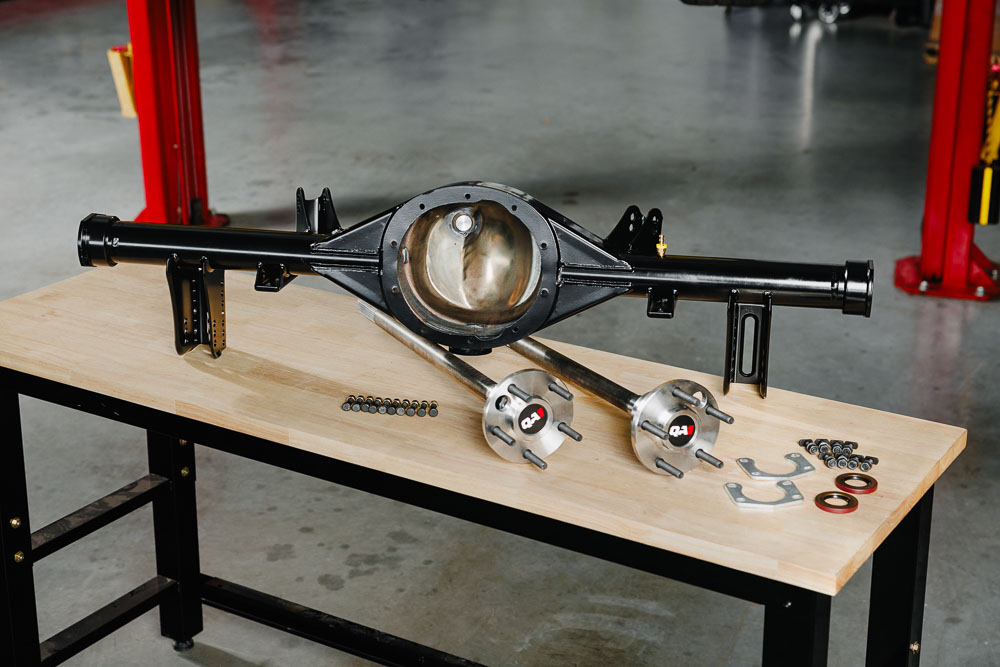
History of Ford's 9-Inch
Ford introduced the 9-inch rear axle in 1957 as an upgrade from their previous hypoid rear axles. It quickly gained favor due to its strength and serviceability. Found initially in full-size Fords like the Fairlane and Galaxie, as well as trucks, its use soon expanded into Ford’s most performance-oriented vehicles, including the iconic Mustang and other muscle cars of the 1960s and ’70s. However, it was the aftermarket that catapulted the 9-inch rearend into legend. While the production of factory 9-inch units ceased in the 1980s, aftermarket companies began producing upgraded housings and internals to meet the demands of high-performance applications.
One of the key reasons for its long-lasting success is the rearend’s adaptability. The 9 inch design was strong enough to handle the torque of larger displacement engines but versatile enough to be used in everything from hot rods to drag cars. Its enduring status in the racing world is due to its combination of design simplicity, ease of maintenance, and a strong foundation that could be modified to handle increasing amounts of horsepower and torque without the failures that plagued other designs when pushed to extremes.
Unique Technical Aspects of the Ford 9-Inch Design
From an engineering perspective, the Ford 9-inch differential set itself apart from its competitors in several critical ways. First and foremost is its third member design, where the entire differential assembly (the carrier, gears, and pinion) can be removed as a single unit. This modular, “drop out” configuration allows for quick changes or repairs without the need for major disassembly of the axle housing. Racers, in particular, benefit from this, as it allows them to swap gear ratios or perform repairs in a fraction of the time compared to other differential designs. By removing the driveshaft and 10 bolts holding the carrier in the housing, the carrier, ring gear, pinion, and axles can be removed independently and serviced or changed on a workbench. This is of great benefit to racers, who often had to work on their backs under the car with earlier rearend designs.
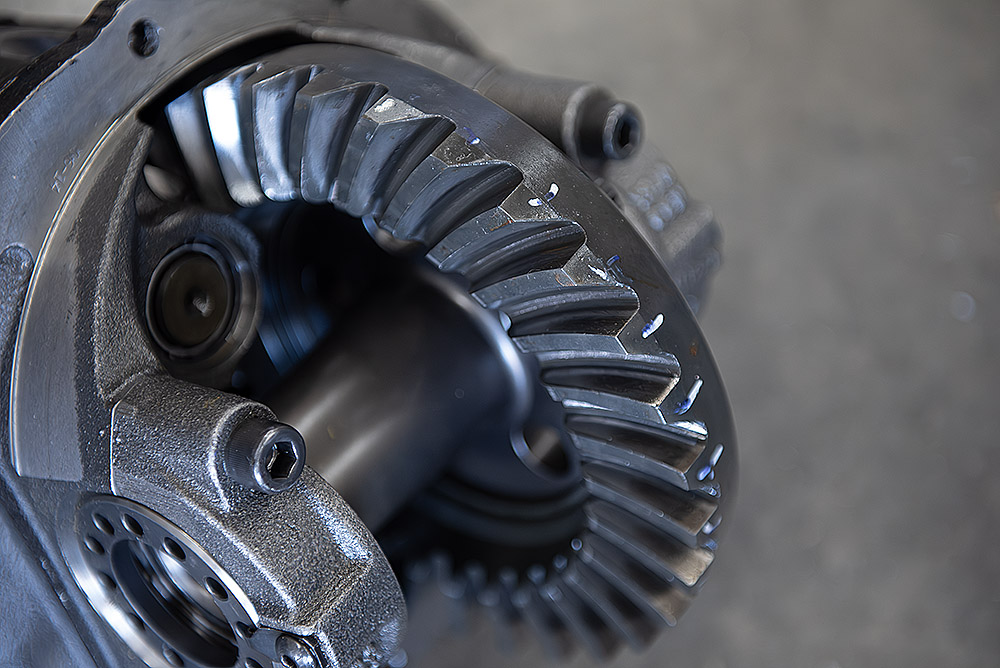
Ring Gear Size
The size of the ring gear is another key element of the 9-inch’s strength. At 9 inches in diameter (hence the name), it is larger than many other factory rearend options, such as the GM 10-bolt or 12-bolt rear axles, giving it a larger surface area to distribute the forces of torque. This feature translates to more durability under heavy loads, making it an obvious choice for high-horsepower applications where failures would be problematic.
Three-Bearing Pinion Support Design
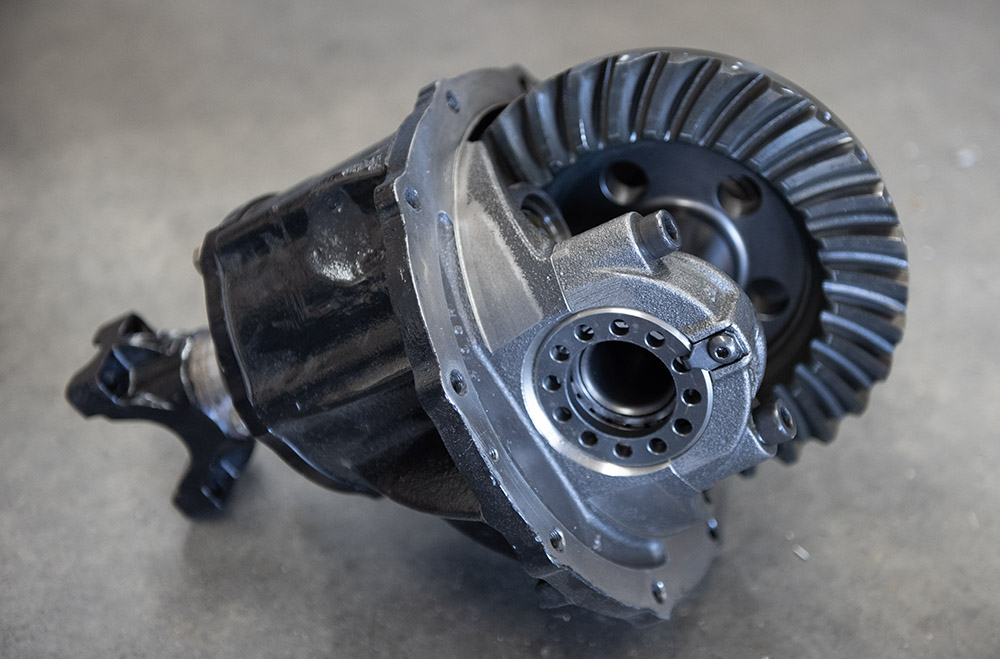
Unlike most rear differentials that rely on two bearings to support the pinion gear, the Ford 9-inch employs a three-bearing system. This additional support provides several technical and performance advantages, particularly in high-stress and high-torque applications.
In most conventional differentials, the pinion gear—responsible for transferring power from the driveshaft to the ring gear—sits on two bearings: one at the front and one at the rear of the pinion. These bearings are responsible for keeping the pinion aligned and ensuring smooth engagement with the ring gear under load. However, when subjected to extreme forces, such as high horsepower or violent launches, the pinion can flex or shift slightly. This can lead to improper gear engagement, resulting in premature wear or even failure of the ring-and-pinion set.
The Ford 9-inch addresses this problem by adding a third bearing at the nose of the pinion gear. This extra bearing provides additional support and stability, minimizing the flexing or movement of the pinion under load. It essentially “locks in” the pinion more securely, allowing for better engagement with the ring gear even under extreme conditions. This third bearing is positioned close to the pinion head, where the gear mesh occurs, making it much more effective at maintaining alignment during high-stress situations.
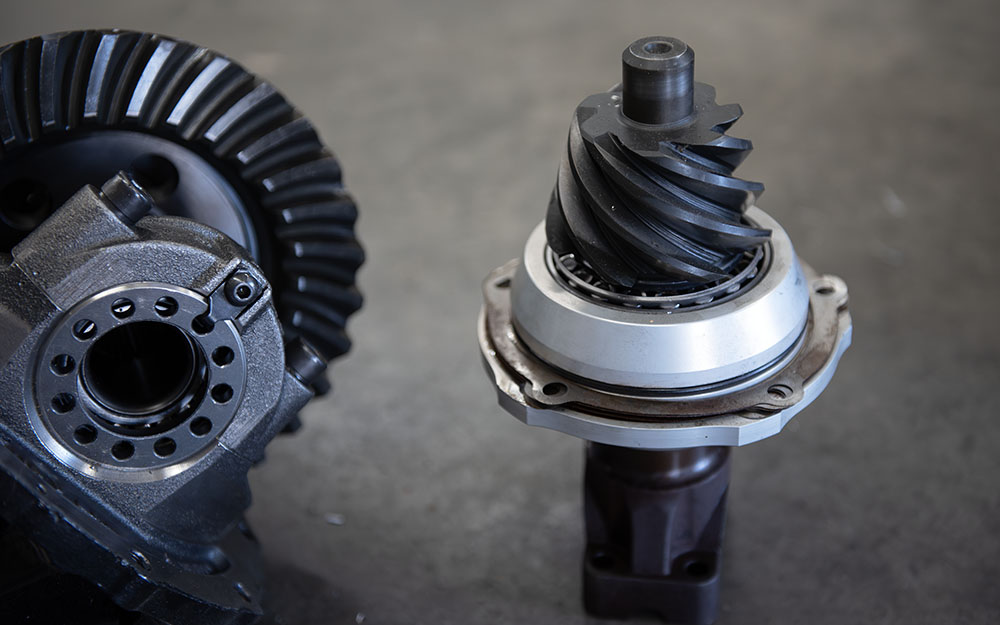
Gear Pitch Angle
One of the lesser-discussed but highly important aspects of the Ford 9” rearend design is the unique pitch angle of the gear teeth. The pitch angle refers to the angle at which the teeth are cut, which directly influences the way power is transferred from the pinion gear to the ring gear. In the 9-inch, this angle is steeper than in other rearend designs, resulting in more surface area contact between the pinion and ring gear teeth.
The use of hypoid gears—where the pinion gear sits below the centerline of the ring gear—is another important aspect of the 9-inch design. This low pinion placement allows for a better engagement angle between the gears, increasing the amount of contact between the teeth. More contact means less stress on each individual tooth, leading to a higher torque capacity. This makes the 9-inch particularly suited for high-performance vehicles where gearsets are subjected to significant loads during acceleration.
The hypoid distance is a standout design feature of the Ford 9-inch rear differential, which sets it apart from other axle designs due to its unique ring and pinion gear configuration. Hypoid distance refers to the vertical offset between the centerlines of the ring and pinion gears. The greater the distance from the center of the ring gear to the center of the pinion gear (the gear offset), the stronger the ring-and-pinion assembly. In the Ford 9-inch, this offset is greater than most competitors, measuring around 2.25 to 2.38 inches.
This steeper pitch angle is critical for several reasons. First, it increases the overall strength of the gearset, allowing the 9-inch to withstand high levels of torque without failure. This makes it an ideal choice for applications like drag racing, where violent, high-torque launches put extreme loads on the drivetrain. Second, the increased surface area reduces the likelihood of gear failure by spreading the load more evenly across the teeth.
This steeper pitch angle does come with one minor drawback: slightly higher parasitic drag. Because the gears engage more fully, there is a small increase in friction compared to more traditional hypoid gearsets like the GM 12-bolt. For street applications, this may result in a very marginal reduction in fuel efficiency, but for race cars and high-performance builds, the virtually unmatched durability and serviceability far outweighs the very minute mechanical inefficiency.
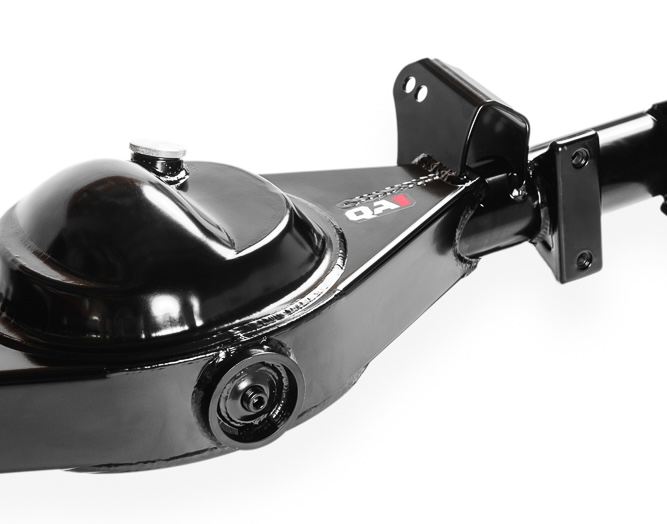
Case Thickness
Ford 9-inch rear end housings are typically available with case thicknesses ranging from .150” to .250”, providing flexibility based on the application and strength requirements. The thinner .150” cases are typically used in lighter-duty or street applications, where weight savings are important and extreme torque loads are less of a concern. In contrast, the thicker .250” cases are designed for high-performance and racing applications, where the housing must withstand severe stresses, such as high horsepower, hard launches, or off-road abuse.
The increased thickness in the .250” cases offers greater rigidity and resistance to deformation under load. This helps ensure that the axle shafts and gears remain properly aligned, reducing the chances of premature wear or failure in high-stress conditions. This range of case thicknesses allows builders and racers to select the appropriate housing based on the specific demands of their vehicle, balancing weight, strength, and durability.
Why the 9-Inch is Still King in the Aftermarket
For automotive enthusiasts and racers, the Ford 9-inch rearend is a virtually standard component, not only because of its strength but also due to its serviceability and customization potential. One of the reasons it has remained so popular for decades is the sheer volume of aftermarket support it enjoys. Virtually every component of the 9-inch can be upgraded or modified to suit specific applications. Whether you’re building a street cruiser or a full-blown race car, the 9-inch can be tailored to your needs.
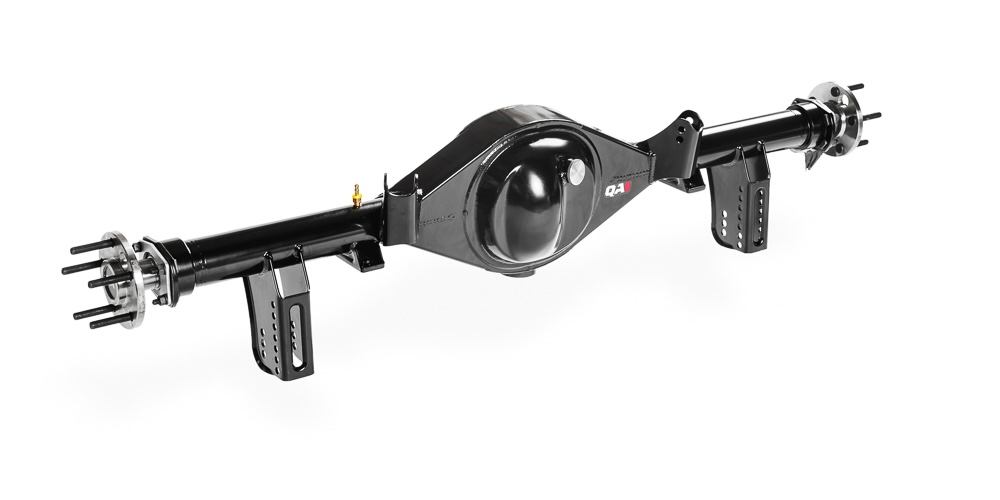
There are several key areas where aftermarket parts have taken the 9-inch to new levels of performance. For one, aftermarket manufacturers offer high-strength chromoly axle shafts that significantly increase the overall durability of the system. Upgraded gearsets are also available, designed with advanced materials and manufacturing techniques to handle horsepower levels well beyond the design limits of the original Ford units. Further improvements, such as heavy-duty bearings, nodular iron housings, and billet pinion supports, allow builders to push the limits of performance even further. So tried-and-true is the basic Ford 9-inch design that all across the motorsports landscape, custom fabricated housings and even larger 10-, 11- and 12-inch ring gear designs for extreme applications utilize the very same modular configuration and hypoid gear design.
The 9-inch ford rearend offers great versatility in brake options due to the removable third member, which simplifies axle and brake upgrades. Its large axle bearings support a wide range of brake configurations, from traditional drum brakes to high-performance disc systems, including larger rotor sizes and multi-piston calipers. This adaptability allows for easy use of aftermarket brake kits, offering enhanced stopping power and improved heat dissipation, essential for high-performance applications. Additionally, the 9-inch housing’s strength accommodates the increased loads from more robust braking systems without compromising its integrity.
Another major advantage of the 9” is its ability to accept a wide range of gear ratios, thanks to the third-member design. Enthusiasts can quickly swap out differentials to change the gearing for various types of racing or street driving. Between the 3.0:1 and 5.0:1 range gear ratios of at least one tenth of a ratio cha age are often available. This versatility is particularly valuable in drag racing, where different tracks may require different ratios to optimize performance. Combined with the variety of locking differentials, limited-slip options, and spool setups available, the 9-inch offers nearly limitless customization.
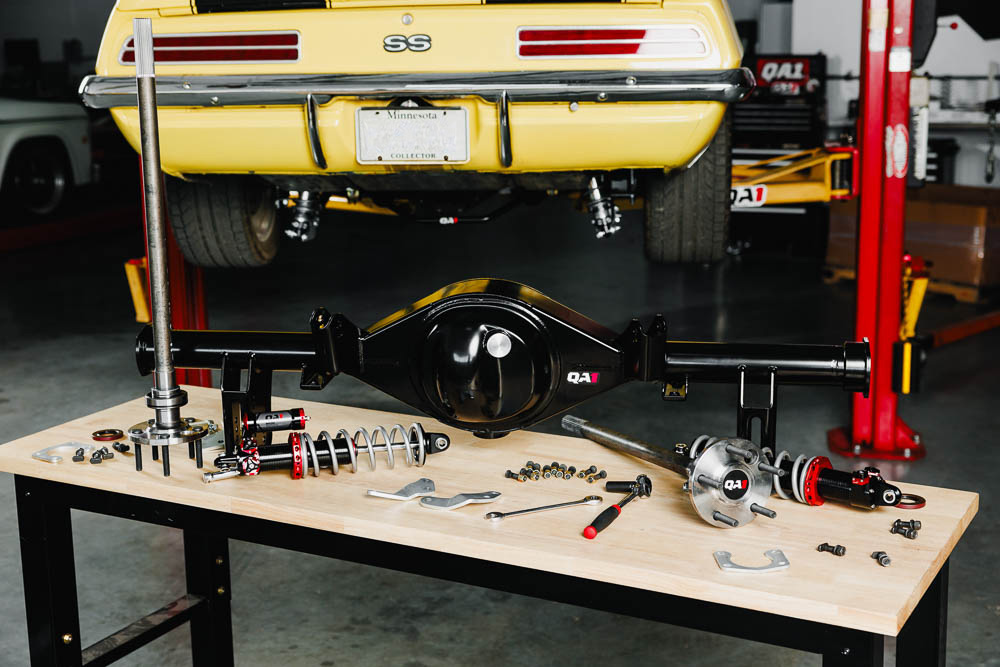
Built For High Performance
The Ford 9-inch’s popularity in racing circles is no accident. Its ability to withstand the abuse of high-horsepower engines, combined with its serviceability, has made it a staple in drag racing, on-road and off-road racing, and circle track events. Drag racers, in particular, have taken to the 9-inch because it handles hard launches and massive amounts of torque without the failures that can plague other rearend designs. When combined with the ability to fine-tune the gear ratios for specific tracks, the 9-inch becomes an invaluable tool in a racer’s arsenal.
In off-road racing, the 9-inch’s strength and modular design allow for rapid repairs or changes in the field, making it ideal for endurance events like desert racing. Off-road vehicles subject their rear axles to brutal impacts, and the 9” has proven capable of surviving these extreme conditions without catastrophic failures.
Its design has stood the test of time, continuously evolving to meet the needs of modern automotive enthusiasts and racers. From its third-member configuration to its massive ring gear and unique pitch angle, the 9-inch remains the benchmark for rearend performance. Even with the advent of more modern axle designs, the 9-inch continues to reign in the aftermarket and racing world.

